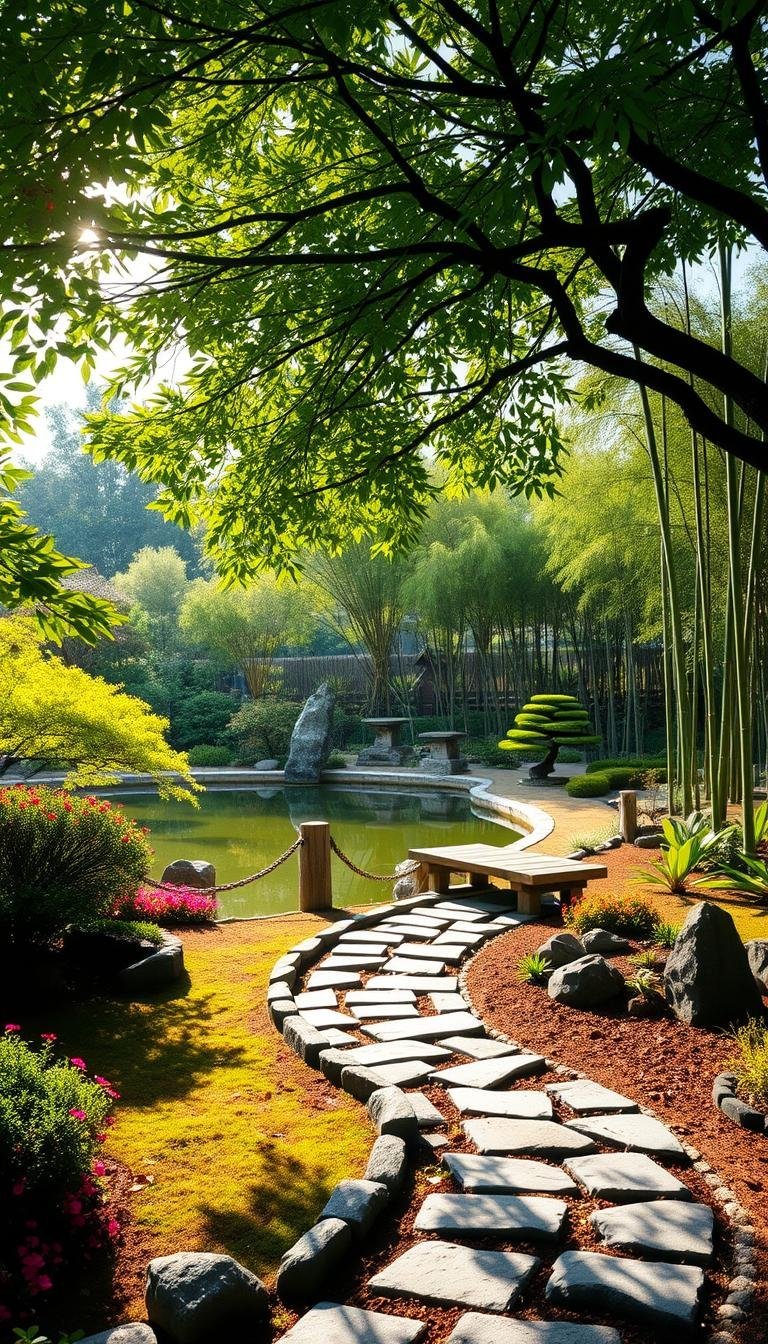(Hey! Some links in this post may be affiliate links — meaning I may earn a small commission if you buy through them, at no extra cost to you. As an Amazon Associate, I earn from qualifying purchases. I only share products I genuinely love and think you’ll find useful too. Read the full disclosure here).
More people are using meditation gardens as personal retreats to reduce stress and connect with nature. A meditation garden can turn any outdoor space into a peaceful place, no matter how small. This guide will help you design a space that brings calm and clarity.
Even a small backyard corner can become a meditation garden with careful planning. These spaces offer a quiet escape from the world, perfect for mindfulness or reflection. Learn how to create a personalized oasis that supports your mental and emotional wellbeing.
Contents
- 1 Understanding the Importance of a Meditation Garden
- 2 Choosing the Right Location for Your Garden
- 3 Essential Elements for a Meditation Garden
- 4 Design Ideas to Inspire Your Meditation Space
- 5 Creating an Inviting Atmosphere
- 6 Incorporating Mindfulness Practices
- 7 Maintenance Tips for Your Meditation Garden
- 8 Personalizing Your Meditation Garden
- 9 Expanding Your Meditation Practice
Understanding the Importance of a Meditation Garden
A meditation garden is more than just plants and paths. It’s a space made to help us find calm. These areas have roots in ancient traditions, like Japanese Zen gardens and monastic courtyards. They follow mindfulness oasisprinciples, blending nature with purpose.
What is a Meditation Garden?
A meditation garden uses natural elements to help clear your mind. It’s not just for looks; it’s for finding peace. Stones, water, and plants are placed to help you think deeply. For example, a stone path might lead you to a quiet spot, helping you leave stress behind.
Benefits of Having a Meditation Space
- Reduces stress hormones like cortisol
- Enhances focus through sensory simplicity
- Promotes emotional balance via exposure to greenery
A 2022 study inEnvironmental Psychologyshowed people usingmeditation gardenspaces felt 40% less anxious after regular visits.
How Gardens Promote Mindfulness
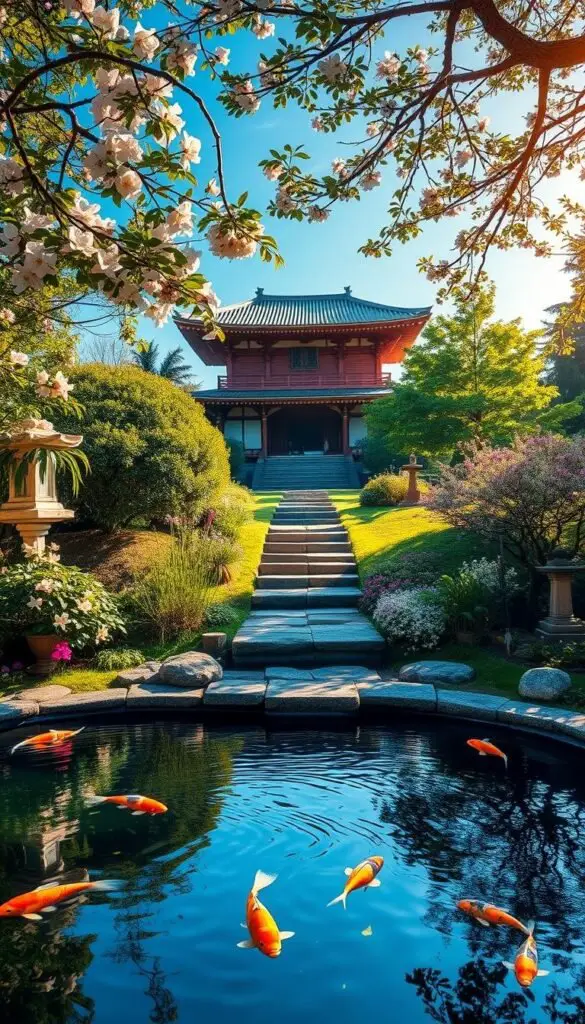
Nature’s elements help us stay present. The sound of a fountain, the smell of lavender, or the feel of leaves underfoot focus our minds. Even small gardens can be amindfulness oasisby keeping things simple.
“A garden is a mirror of the soul’s quiet moments.”
This idea makes any outdoor space a place for easy meditation.
Choosing the Right Location for Your Garden
Finding the perfect spot for your meditation space begins with looking at your yard’s natural layout. A peaceful retreat needs careful placement that fits your daily life and the land’s features. Follow these steps to create a mindful oasis from an ordinary corner.
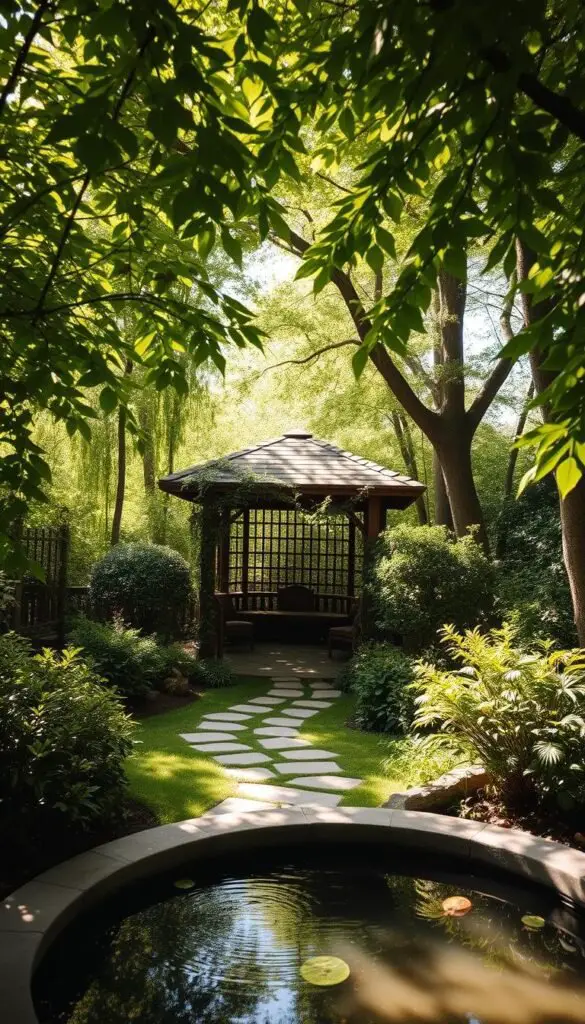
Factors to Consider for Site Selection
Start by asking yourself these questions:
- Is the area easy to get to but feels far from daily life?
- Does the soil drain well after rain?
- Can the space blend with existing trees or slopes?
Privacy and Noise Levels
Keep your peaceful retreat quiet with these tips:
- Plant dense bushes like bamboo or arborvitae to block views.
- Use trellises draped with vines to soften harsh sounds.
- Position your seating under mature trees for natural sound barriers.
Sunlight and Shade Considerations
Let light guide your design choices:
Full-sun zones are great for vibrant flowers and morning meditation. Shaded areas offer cool relief in warm climates. Pair plants like hostas or hydrangeas with shaded corners for a calming effect.
Essential Elements for a Meditation Garden
A meditation garden needs key elements to bring calm and focus. These parts work together to make a peaceful place. Start by picking plants that feed both your senses and soul.
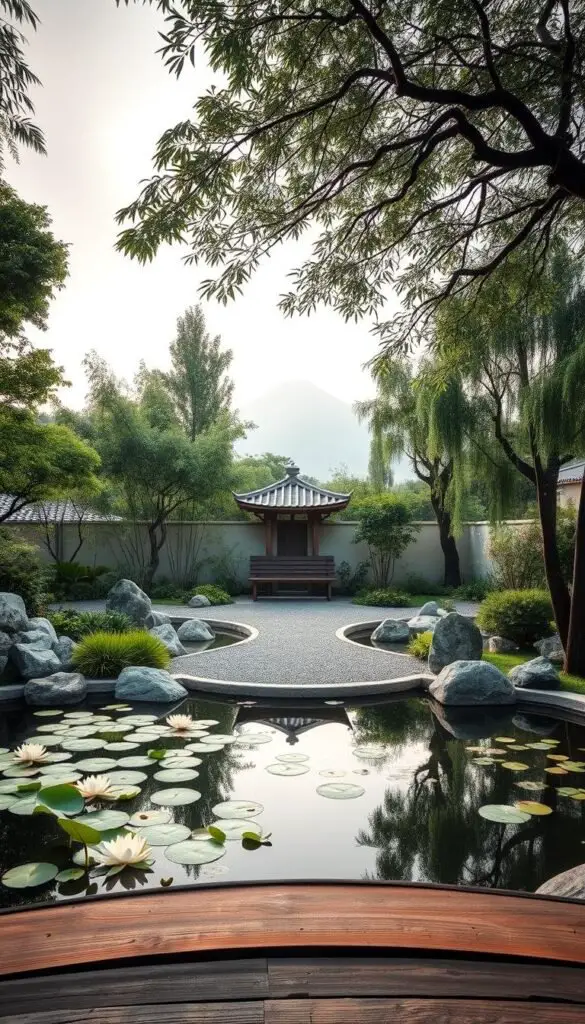
Choosing the Right Plants and Flowers
Choose plants with soft textures and calming scents. Lavender is great for its smell, bamboo for its gentle sound, and hosta leaves for their shade love. Herbs like mint or rosemary release scents when touched, helping you stay present.
Native plants are easy to care for and keep nature in balance.
Incorporating Water Features
- Small tabletop fountains muffle outdoor noise
- Bubbling stone basins add motion without overwhelming the calm
- Rain chains above a barrel create rhythmic sounds
Even a shallow bowl with floating lilies can be a focal point in your meditation garden. It turns water into a meditative spot.
Using Rocks and Pathways for Structure
Stone paths guide you through the garden, like life’s path. Arrange river rocks in patterns to show order. Raked gravel patterns, inspired by Japanese zen outdoor space traditions, invite mindful care.
Use flat stepping stones to set boundaries without blocking views.
Design Ideas to Inspire Your Meditation Space
Ready to bring your meditation garden to life? Explore these three design styles to craft a space that aligns with your personal preferences and enhances your mindfulness practice.
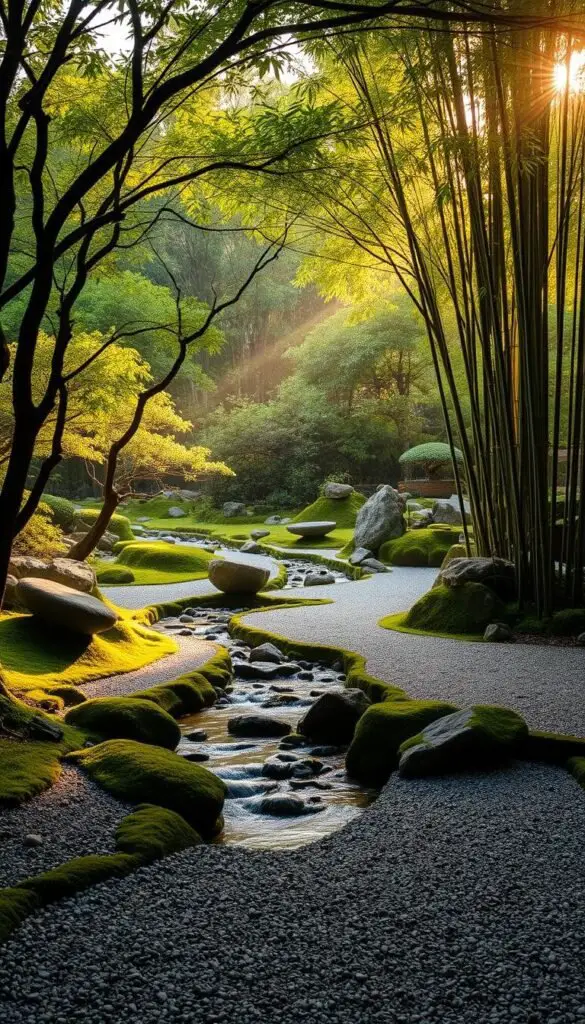
Zen Gardens: A Minimalist Approach
A Zen garden transforms simplicity into serenity. Inspired by Japanese karesansui designs, these spaces use raked gravel, weathered stones, and minimal foliage to foster contemplation. Arrange rocks to symbolize mountains or islands, and let the repetitive gravel patterns anchor your focus. This minimalist style turns any corner into a tranquil haven rooted in quiet elegance.
Flowering Gardens for Vibrant Energy
For those drawn to color, flowering gardens blend beauty with mindfulness. Choose perennials like lavender or black-eyed susans that bloom in cycles. Bright hues like marigolds or soft pastels from peonies can uplift moods while grounding you in the present. Tranquil haven doesn’t mean muted—vibrant blooms can revitalize your practice without distraction.
Forest Gardens: Nature’s Embrace
Immerse yourself in a woodland retreat by layering plants like ferns, hostas, and shade-loving shrubs. Dappled sunlight filtering through canopy trees creates a natural canopy, while moss-covered stones and decaying logs add raw, organic texture. This design channels the calming effects of shinrin-yoku (forest bathing), turning your yard into a tranquil haven that mirrors wild landscapes.
Creating an Inviting Atmosphere
Make your meditation space welcoming with careful details. The right seating, scents, and lighting can turn any garden into a inner peace garden. It will help you find calm, day or night.
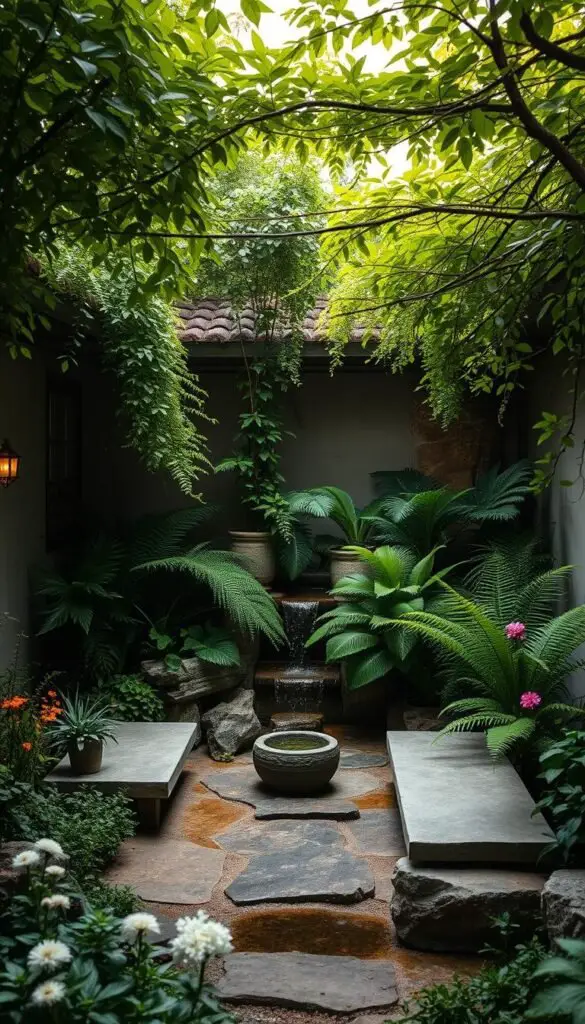
Selecting Comfortable Seating Options
Choose seating that supports your body and mind. You can find:
- Weatherproof benches with backrests
- Stackable meditation cushions
- Recycled-plastic loungers
Place seating near beautiful spots like water or trees. Use materials like memory foam or bamboo for extra comfort.
Adding Aromatic Elements
Use nature’s scents to enhance your mindfulness. Plant rosemary or lemon thyme for fresh smells. Hang cotton diffusers with lavender oil for a calming scent.
In the evening, light sandalwood incense for a grounding aroma.
Using Soft Lighting for Evening Meditation
Soft lighting makes your garden perfect for evening meditation. Consider:
- Solar-powered string lights along pathways
- Dimmable LED lanterns
- Oil lamps with glass shades
Stay away from harsh white lights. Warm tones are better for keeping the inner peace garden feel without hurting your night vision.
Incorporating Mindfulness Practices
Turn your meditation garden into a daily escape by mixing mindful habits with nature. A well-thought-out space turns into a mindfulness oasis when used with purpose. Start by seeing your garden as a place for deep thinking and personal growth.
Techniques for Meditating in Nature
Walk mindfully on the garden paths, feeling each step. Notice how light passes through leaves or the sound of water. Try the “5-4-3-2-1” exercise: list five plants, four colors, three textures, two sounds, and one scent to quiet your mind.
Designing Space for Movement
Create a spot for yoga or stretching. Look for flat, stable areas like gravel or permeable pavers. Add a bamboo screen or dense shrubs for privacy. Here are some tips:
- Place mats where sunlight warms the ground in the morning
- Leave 6×6 foot open areas for sun salutations
- Use non-slip stones as alignment markers
“Movement in nature becomes meditation when the body and earth move as one.” – Yoga Journal
Journaling Nooks for Reflection
Set up a writing area with a weatherproof bench and small table. Place it near calming spots like a birdbath or herb garden. Keep a waterproof notebook and colored pencils for sketching. Pair journaling with sunset routines to capture daily insights.
Make mindfulness a daily habit by spending 10 minutes each day in your mindfulness oasis. Let the meditation garden change with the seasons—autumn leaves, winter frost, or spring blooms all offer new things to focus on.
Maintenance Tips for Your Meditation Garden
Keeping your meditation garden in top shape ensures it remains a serene sanctuary all year. By turning maintenance into mindful moments, you create a peaceful and welcoming space. Start by planning seasonal care routines that meet your plants’ specific needs.
Seasonal Care for Plants
Create a calendar for tasks like pruning, mulching, or fertilizing. For example, spring is the best time for mulching, and fall is for raking leaves. Choose plants that are drought-tolerant in dry areas to save time and effort.
Pathway Maintenance
Keep walkways safe by clearing debris and fixing cracks quickly. Use organic herbicides to control weeds and keep the garden’s natural feel. For gravel paths, check for compaction and level them after winter to ensure a smooth walk.
Water Feature Care
Clean your water feature’s pump every 6–8 weeks to stop algae growth. A
“a calm pond reflects the sky; a calm mind reflects peace”
reminds us that clarity is worth the effort. Test your filtration system seasonally and store fountains in freezing weather.
See maintenance as part of your meditation practice. Each task is a chance to connect with your garden. Regular checks keep your serene sanctuary thriving without taking too much time. A well-kept garden invites meditation, not stress.
Personalizing Your Meditation Garden
Your peaceful retreat becomes a true sanctuary when it mirrors your unique identity. Whether through symbols, quotes, or shared efforts, personal touches turn a garden into a space that evolves with your journey.
Add Statues or Inspirational Quotes
Small statues—a stone crane, a Buddha figurine—or engraved plaques with quotes like “Be Stil and Know” invite reflection. Consider:
- Sacred symbols (om signs, mandalas)
- Weatherproof art from brands like Garden Art Co. or Wind & Weather
- Quotes by poets like Rumi or Thich Nhat Hanh
Create a Theme That Resonates with You
Choose themes that align with your values. A zen outdoor space might embrace:
- Cultural motifs (Japanese karesansui, Native American dreamcatchers)
- Nature-inspired palettes (blues for calm, earth tones for grounding)
- Personal mementos (travel souvenirs, family heirlooms)
Involving Others in the Design
Invite loved ones to co-create your space:
- Plan a family planting day for shared herb beds
- Host a “bring an item” potluck for collaborative decor
- Design group yoga areas with shared meditation spots
“The garden becomes a mirror of the soul when we infuse it with intention.”
Let your peaceful retreat grow as your mindset evolves. A space that evolves with you becomes more than a garden—it’s a living meditation.
Expanding Your Meditation Practice
Your meditation garden is more than a quiet spot. It’s a place that can grow with you. As seasons change, so can its role, becoming a place for growth and connection.
Transform Your Space into a Creative Oasis
Make your garden a place for creativity. Host tea ceremonies, art workshops, or poetry circles. The garden’s calm energy sparks inspiration.
Even small areas can be reading nooks or places for journaling. Add seasonal flowers or paths to guide activities. This keeps the garden peaceful.
Open your garden to those seeking peace. Organize meditation circles or yoga sessions. Use soft lights and comfy seats.
Lead guided walks or breathing exercises. This way, guests leave feeling refreshed. Add benches to welcome more without losing the garden’s feel.
Nurture Growth with Nature’s Rhythms
Grow closer to nature with forest bathing or planting. As you learn more, update your garden. Add a water feature for sound therapy or plants that lift your mood.
Your garden will change as you do. It shows that an inner peace garden is as dynamic as the mind it supports.

